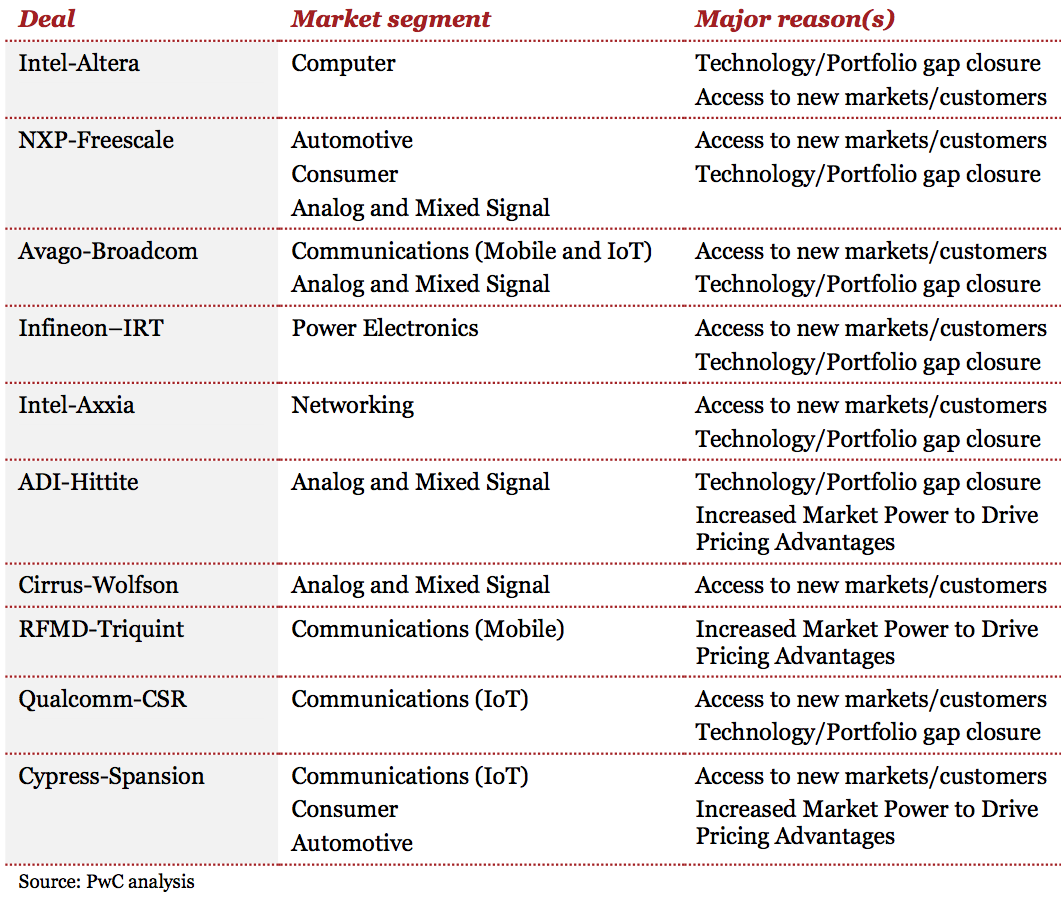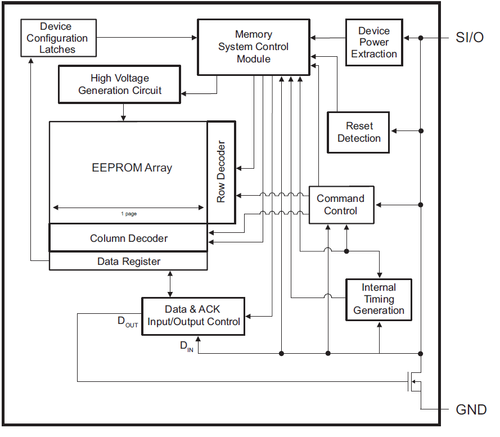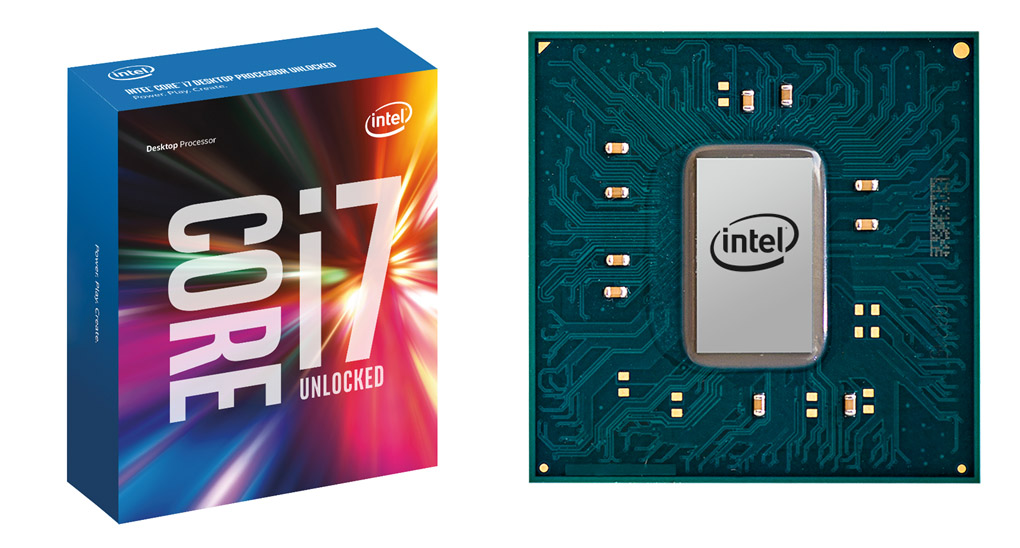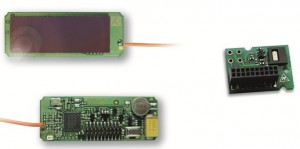New business models, acquisitions, investments are changing the semiconductor ecosystem.
Shifting business models, acquisitions, minority investments and
increasing uncertainty are creating fundamental shifts in the
semiconductor industry that could redefine who is successful in which
markets for years to come.
The announcement today that
Rambus
is developing memory controller chips, expanding its business beyond
just creating IP for the memory and security markets, is the latest in a
stream of public disclosures and behind-the-scenes deals that have been
underway for the past 18 months. And while the Rambus move is
significant by itself, in the context of all the other moves over the
past 18 months it blends into a landscape of equally dramatic changes.
A just-released PricewaterhouseCoopers report identified several
drivers for the recent string of semiconductor industry acquisitions.
Among them are access to new markets or customers, closing up gaps in
portfolios, resource augmentation to enable scaling, and increased
market leverage.

“As any industry experiences slower growth and increasing cost
pressures, consolidation is a natural step,” said Rakesh Mehrotra, PwC’s
U.S. semiconductor advisory leader. “Semiconductor companies below $500
million are experiencing consolidation for this same reason and being
acquired by larger semiconductor companies. As new applications achieve
success and higher growth rate returns, we will see reduced
consolidation.”
Mehrotra noted that a good part of that consolidation is being driven
by a need to close up product portfolio gaps for emerging applications,
such as IoT/IoE and M2M. “Companies are exploring ways to offer
complete integrated solutions spanning sensing, processing, and
connectivity. Many of these capabilities are being integrated into
either a single-chip or a single-package to offer a more competitive
solution. In addition, we see consolidation is helping companies improve
their position in existing markets through scale efficiency and
increased share of wallet at key customers.”
In Rambus’ case, the opportunity fits a couple of those criteria,
namely access to new markets and portfolio gap closure. Jerome Nadel,
the company’s chief marketing officer, said it has been getting harder
and harder to create a server interface for DDR4 and top customers were
asking for help. The challenge for Rambus was developing a cohesive
strategy for continuing to provide IP—what Nadel calls “IP as a product
and IP in a product” — while making sure it didn’t step on the toes of
existing memory chip customers.
The solution was a DDR4 memory interface chipset that competes
directly with companies such as IDT, China’s Montage Technology, and
Inphi, but none of Rambus’ memory IP customers. At the same time,
considering that Rambus has been developing IP to work with this
interface technology for years, it adds another potential revenue stream
to Rambus’ IP portfolio. It will be designing and selling chips for the
first time using a fabless model.
“There are a couple of key market trends underway here,” said Ely
Tsern, vice president of Rambus’ memory products group. “One is the big
data wave, with an increase in memory, bandwidth and capacity, and there
has been a big uptake in servers and data centers. The second is a
transition from DDR3 to DDR4, which started last year and is seeing a
rapid adoption curve. The problem, though, is that DDR4 is really hard,
and it’s designed to increase in speed every year. To make that work,
you need buffer chips to see an increase in speed, and there are some
new fundamental challenges in the technology.”
Set in the context of the semiconductor IP industry, however, this deal isn’t all that surprising.
ARM,
Synopsys,
Cadence,
Mentor Graphics
and Rambus all have been buying up IP companies that are logical
extensions of their businesses into adjacent markets, such as software,
security, processors, subsystems, and memory verification IP. For all of
these companies, this has proven to be extremely lucrative. That
accounts for a string of Cadence acquisitions, elevating the company
from a virtual no-show in the IP business to the No. 4 hardware IP
provider, and it puts perspective on Mentor’s concerted push into
automotive software.
Even on the hardware side, these kinds of expansions are not out of the usual.
NXP‘s pending acquisition of
Freescale and
Intel‘s pending acquisition of
Altera
have a similar objective of growing share in their respective chip
markets. In fact, Intel sold off its FPGA business to Altera in the
1990s, and now is buying back that business plus the rest of Altera. The
company also purchased Docea Power late last month, ostensibly to help
with power and thermal simulation/modeling when Intel and Altera chips
are integrated together.
“This is the verticalization phase of the industry,” said Patrick
Moorhead, president of Moor Insights and Strategy. “We see this cycle
every 7 to 10 years, where the specialists realize that the sum of the
parts has more value than the parts. This is more of a
solutions-oriented approach, and you see this with companies like Apple,
as well as with ARM and TSMC, where you can have your part based on
what is a hard macro. ARM could produce chips if it wanted to. And MIPS
started out with chips, then moved to IP, and now is back to chips.
Really what this comes down to is control of the investment.”
Moorhead noted that with Rambus, there was a lot of pull from server
OEMs. “There was a demand for a new look and vision, and ironically it
was the end customers driving this. And Rambus was already getting so
far into debugging and fine-tuning that they were doing a lot of the
work, anyway.”
A bigger question mark for the whole ecosystem involves offshore
investments, particularly from China, which could accelerate all of
these moves and force deals as defensive measures. China’s technology
industry is looking to fill in gaps in its current offerings, and it is
much faster to buy than to build. That has has prompted a proposed $23
billion bid by Tsinghua Unigroup, a state-owned chip design company, for
Micron. According to Srini Sundararajan, analyst at Summit Research
Partners, that proposal is likely to evolve into an investment rather
than an acquisition due to national security concerns by the U.S.
government.
And behind all of this are questions from investors about where the
value will be for semiconductors over the next few years. While the
declines are flattening, according to the PWC report, the reduction in
ASPs from a high in 1995 and a resurgence in 2005 mean companies have to
fight for fewer dollars in hardware, or pick alternative approaches in
adjacent markets.
There are some bright spots, though. “For certain segments such as
automotive and industrial we expect to see ASPs stabilize driven by both
scale effects and the growing demand for semiconductor ICs within these
applications,” said PwC’s Mehrotra. “ASPs for computing and consumer
segments will continue to face downward pressure, especially for devices
such as sensor ICs and low-power embedded processors which are
experiencing growing volume forecasts.
http://semiengineering.com/fundamental-shifts-in-chip-business/







